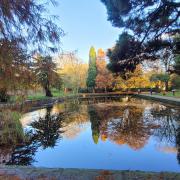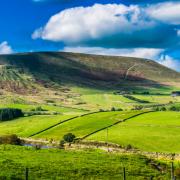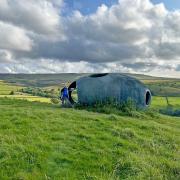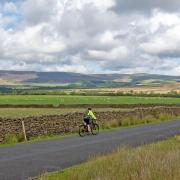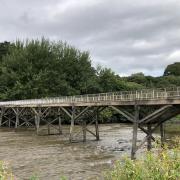Keith Carter describes a route across the moors which gives views over Ramsbottom and Holcombe
The moors loom above the valley of the River Irwell in which the metropolitan settlements of Haslingden, Ramsbottom, Tottington and Bury sprawl, all owing their origins to the power of the river which provided motive power to the mills both dark and satanic.
The moors were what fed the river, as well as being a short-cut to neighbouring townships and a thoroughfare for moving goods and driving livestock to market and the traces of these old routes are still in use today, as recreation for ramblers like us.
Vehicular traffic, even four-wheel drives, would not make much headway over the top of the moors although I’m sure they’d like to give it a try.
Walkers have to share their paths with mountain bikes, trail bikes and souped-up Landrovers in most of the wild places left to us, more’s the pity, so it is important we hold out against the incursion of these intruders.
Climbing Holcombe Hill was a traditional Good Friday activity preceded by egg rolling, a pastime inexplicable to Southerners - ‘Let me get this right - you paint a funny face on a hard-boiled egg and roll it down the hill?’
Peel Tower stands right above Holcombe village, a prominent landmark and the objective for those who climb the hill. Built in 1852, it commemorates the Victorian politician Sir Robert Peel who was born in Bury, going on to reach the highest position in the land and found the modern police force. My recollection of sixth form history also credits him with repealing the Corn Laws but what they were and why they were repealed has faded into the soup of memory, a repository that grows ever larger the more I forget.
There is a convenient car park on the B6214 just south of Holcombe village. The most direct route up to Peel Tower is to cross the road to a gate and take the well-made path beside the wood to a second gate and emerge on a cobbled lane known as Holcombe Old Road. Turn right and at the next junction left onto Moorbottom Road, the signs indicating the way to the tower.
At the next junction a short-cut climbs the bank by way of a series of steps but by turning right a broader and more gradual track leads steadily to the tower, passing the hilltop farm called Top o’ th’ Moor. Nobody could fault the use of the apostrophes or indeed the accuracy of the name.
The 128ft monument is soon in view. They open it up on summer weekends and you can climb to the top to marvel at the surrounding panorama including Ramsbottom spread out below. The name Ramsbottom derives from ‘ram’ meaning a male sheep and ‘bottom’ meaning the hind-quarters. There you have it - the hind-quarters of a male sheep. Aren’t you glad of my scholarship in place names?
A number of paths lead away from the tower but we need to take the one that skirts to the right of a shallow quarry, or bowl, to the north. This obvious path can get muddy but you can pick your way avoiding the worst of the clag. Go through a double gate and keep forward, soon crossing a stream that has carved a gully through the peat.
Soon we begin to climb a low hill surmounted by a pile of stones and the next landmark is a stone obelisk known as the Pilgrims Cross, not a cross now although it marks a crossing-point on the moors that would have been known for centuries.
It is said the monks of Whalley Abbey used this way across the moors. Holcombe Moor is owned by the National Trust but they must have an arrangement with the Army since much of it is used for live firing. My mate Jim said he could hear artillery but I said I had not realised the Army was issuing twelve bores now. Various signs and flagpoles attest to the proximity of a danger zone but there were no red flags flying and I hazarded that we could get across without getting our heads blown off.
Leaving the Pilgrims Cross, the path divides and we take the right fork, the going level and easy. Passing a pile of stones, look for an upright pillar with the initials ES carved at the bottom. This marks the spot where Ellen Strange was murdered as she crossed the moor one dark and stormy night. They arrested John Broadley for the murder and sent him for trial at Lancaster Assizes where he was acquitted for lack of witnesses.
If you want my opinion, I reckon he did it, the swine.
The path begins to descend and at a wall corner with two gates we find an interpretive board erected by Stubbins Estates. Don’t go through either of the gates but turn back sharp right on a wide track, one of the old drovers’ roads we find on these moors.
We pass by two isolated farms and remain on the track all the way to where it joins the road opposite the Shoulder of Mutton pub in Holcombe. If you arrive during opening hours, don’t hold back, go in for a pint. We did, didn’t and did, if you follow my meaning, my choice being Black Sheep and Jim’s a Bolton ale known as Old Slapper. I shall make no further comment on the appropriateness or otherwise of his choice.
From the pub it is only a few hundred yards along the pavement to the Peel Tower car park. An excellent walk, just right no matter what the weather. Try it.
Compass points
Area of walk: Holcombe, Ramsbottom.
Map: OS Explorer 287 West Pennine Moors
Distance of walk: 5 miles
Time to allow: 2 � hours
Refreshments: Shoulder of Mutton, Holcombe















